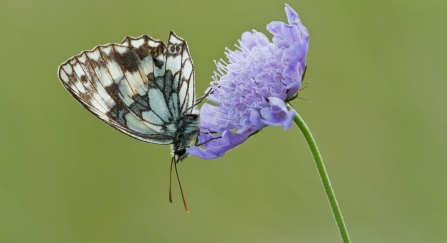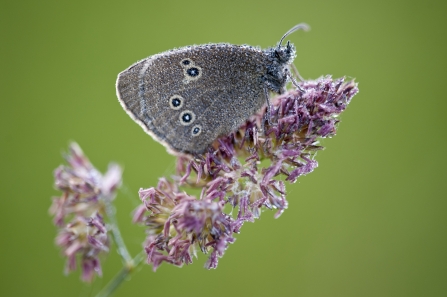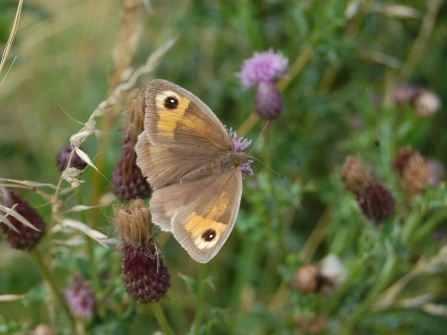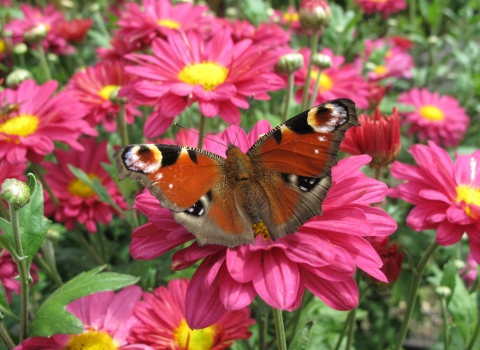2019 was the best year for butterflies since 1997
Summer heat boosts butterfly numbers!
A butterfly in a thriving wildflower meadow. Photo by Jon Hawkins/Surrey Hills Photography
Recently published data from the annual UK Butterfly Monitoring Scheme (UKBMS), which is organised by a group of national wildlife organisations, has revealed 2019 was the best year for butterflies since 1997.
In fact, it was the 8th best year for butterflies since monitoring began in 1976. Compared to 2018, over half of Britain’s butterfly species increased in number.
The perfect combination of warmth, sunshine and regular rainfall helped caterpillar development as well as adult butterfly emergence.
Hungry caterpillars were able to feast on lush and well-watered food plants, and adults emerged in good numbers and had plenty of opportunity to breed and lay plenty of eggs.
The record-breaking heat of 2019 helped some species record their best year since monitoring began.

Marbled White (Melanagria galathea) resting on Small Scabious (Scabiosa colombaria) by Guy Edwardes/2020VISION
The distinctive black and white marbled white, which can be found in areas of unimproved grassland, was one of the biggest success stories. Not only did existing colonies thrive but they also continued to spread north and colonise new sites.
Surprisingly, those species which experts had feared would suffer due to the prolonged drought in 2018 also fared well.
A common sight of the summer two years ago was brown and parched grassy areas including meadows and garden lawns. It was feared butterflies, whose caterpillars feed on grass, would suffer in 2019 but unexpectedly two of our most familiar grass-eating species, the ringlet and meadow brown recorded their second-best and fifth-best years on record respectively.

Ringlet butterfly by Ross Hoddinott/2020VISION
A fantastic army of thousands of nationwide volunteers monitoring just over 3,000 sites has helped experts assess how most of the UK’s butterfly species are coping with long-term climate change, annual weather patterns and modern farming practices.
As part of BBOWT’s Reserves Monitoring Programme, 52 volunteer surveyors recorded butterflies on 37 of the Trust’s nature reserves across the three counties.
The data collected in our Upper Thames region has made an important contribution to the national recording scheme, as well as helping the Trust assess how butterflies are responding to management work on our reserves.
BBOWT nature reserves also recorded a bumper year for marbled whites with particularly healthy populations identified at Warburg Nature Reserve in Oxon, Moor Copse in Berks and Grangelands in Bucks.
The Trust’s volunteers recorded a staggering 49,949 butterflies of 41 species during their 2019 survey work!

Only a single migrant clouded yellow was recorded all year, and the commonest butterfly by far was the brown and orange-coloured meadow brown with 15,295 sightings!
Many of our familiar spring species also enjoyed a bumper year. The vivid yellow brimstone, often the first butterfly most people see each year, thrived in 2019 and early signs are it is also faring well this spring.
Many of BBOWT’s volunteers have reported good numbers visiting their gardens during the recent warm weather this March. It is thought by some the word 'butterfly' originates from the yellow colour of male brimstones.
Another species to look out for in gardens and local green spaces is the gorgeous orange-tip, on the wing from early April. As the name would suggest, the male is very distinctive with vivid orange tips to the wing contrasting with the mostly white wings and body.
Watching a stunning small tortoiseshell or peacock butterfly nectaring from the flowers in your garden is guaranteed to bring you great joy. Spending time with nature offers a precious distraction from the current uncertain and troubling times.

Grow a secret garden for butterflies
Our gardens can provide important places, homes and food sources for butterflies. There are lots of things that you can do to make your garden even better for butterflies
